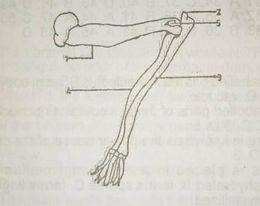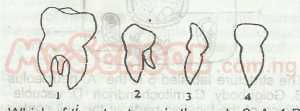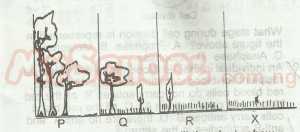
Which ecological factor exerts the greatest influence on the structure of the profiles?
- A. Topographic
- B. Edaphic
- C. Biotic
- D. Climatic
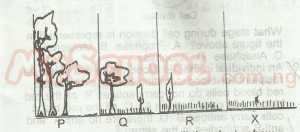
In which of the habitats will plants show xeromorphic features most prominently?
- A. X
- B. R
- C. P
- D. Q
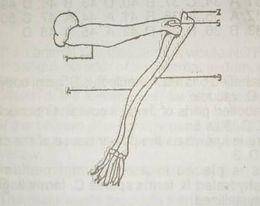
What is the name of the structure labelled 2?
- A. Odontoid process
- B. Olecranon process
- C. Patella
- D. Condyle
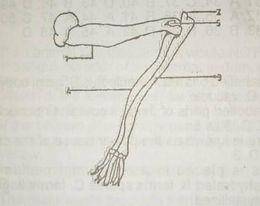
The type of joint at the point labeled 5 is the?
- A. pivot joint
- B. gliding joint
- C. ball and socket joint
- D. hinge joint
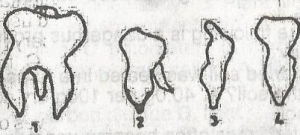
What is the function of 3?
- A. cutting of large piece of food
- B. seizure and tearing of prey
- C. Grinding of food
- D. Tearing of flesh only
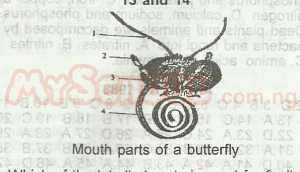
The structure labelled 2 is the
- A. compound eye
- B. ocellus
- C. antenna
- D. labial palp
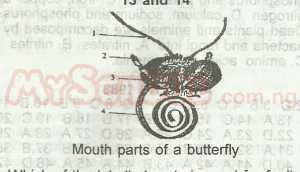
Which of the labelled parts is used for feeling?
- A. 1
- B. 2
- C. 3
- D. 4
Farmers practise crop rotation because it
- A. helps to prevent soil erosion
- B. allows two crops to be planted at the same time
- C. helps to conserve soil fertility
- D. is an alternate to shifting cultivation
Most irrigated lands often become unproductive in later years because of
- A. loss of fertility
- B. increase in salinity
- C. soil erosion
- D. loss of water
5 g of oven dried soil was heated in a furnace for 24 hours. After cooling, it weighed 4.8 g. What is the amount of humus in the soil?
- A. 40.0g per 100 g dry soil
- B. 4.4g per 100g dry soil
- C. 4.0 g per 100g dry soil
- D. 0.4g per 100g dry soil
Which of the following is a dangerous product of coal burning?
- A. Sulphur dioxide
- B. Carbon dioxide
- C. Carbon
- D. Nitrogen
which of the following disease can be caused by a bacterium?
- A. Ringworm
- B. Poliomyelitis
- C. Malaria
- D. Syphilis
which of the ways of controlling bilharzia can result in pollution?
- A. clearing water weeds on which the snail feed
- B. Treating infected people with drugs
- C. Preventing contamination of water by infected urine and faeces
- D. Applying chemical to kill the snails
A physiological adaptation of plants to the problem of excessive water loss is
- A. reduction in the number of stomata
- B. reversal of the normal stomatal rythm
- C. possession of shallow roots
- D. ppossession of waxy curticle
Lichen is an example of
- A. saprophytic organism
- B. a symbiotic association
- C. an epiphytic plant
- D. a carnivorous plant
In an ecosystem, the LEAST efficient energy transfer link is from
- A. producers to primary consumers
- B. sun to producers
- C. primary consumers to secondary consumers
- D. secondary consumers to decomposers
Which of the following is a sex-linked character?
- A. Sickle-cell anaemia
- B. Tongue rollling
- C. Skin colour
- D. Colour blindness
If parents with blood groups AB and O produce six children
- A. three of them will have group B
- B. two of them will have group A
- C. all the offspring will have group O
- D. none of them will have group A
when the two alleles present in an organism are of the same type, the genotype is described as
- A. heterozygous
- B. heterogamous
- C. homozygous
- D. homologous



